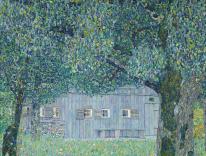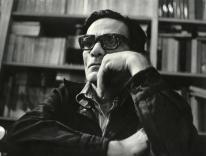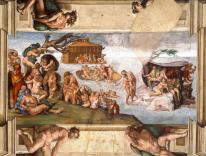“The Word of God in the Life and Mission of the Church” was the subject of the triennial synod of bishops held in Rome from October 5 to October 26. Though overshadowed in the media by economic woes and the U.S. presidential campaign, the synod was an event of great significance. For the first time, a Jewish rabbi spoke to the synod and the Patriarch of Constantinople, Bartholomew II, delivered a substantive address. At the close of its work, the synod presented fifty-five propositions to Pope Benedict, who will now compose a post-synodal “apostolic exhortation.”
The heart of the synod’s theological and pastoral reflection on the Word of God is its confession that Jesus Christ himself is the incarnate Word—the Word of God in the most proper sense. Thus Christianity, the synod suggests, is not fundamentally a religion of the book, but of a person: the person of Jesus Christ. “The hint half guessed, the gift half understood, is Incarnation,” T. S. Eliot wrote in “The Dry Salvages.” The purpose—and achievement—of the synod was to understand this gift more fully.
The indispensable role of the Bible is to be a privileged witness to God’s Word spoken in both creation and history. Hence, speakers at the synod spent some time discussing the various methods needed to do justice to the uniqueness of the biblical witness. Because the Word’s Incarnation was an event in human history, historical-critical exegesis is indispensable. But this kind of exegesis must be complemented by the kind of theological interpretation that acknowledges the transcendent reality of God’s invitation to humanity and affirms its fulfillment in Jesus Christ. Bishops and lay participants alike spoke frequently of the need to encourage the practice of lectio divina, the spiritual meditation on Scripture by which we allow God’s Word to address us in the concreteness of our everyday lives. This practice begins with the “letter” of Scripture but then opens beyond it to the Spirit who alone can vivify and transform us.
Though the Bible is the church’s privileged access to the Word, there are other mediations of the Word that the tradition recognizes and fosters. Patriarch Bartholomew’s address was a forceful reminder of the important role the icon plays in Eastern Christian theology and spirituality. In the face of iconoclastic challenges, the church has defended both the legitimacy and the efficacy of artistic representations of Christ, Mary, and the saints. It has taught that art can attune our senses to transcendent realities. In the Patriarch’s words: “Icons are a visible reminder of our heavenly vocation.... They encourage us to seek the extraordinary in the very ordinary, to be filled with the same wonder that characterized the divine marvel in Genesis: ‘God saw everything that he made; and, indeed, it was very good’ (Gen 1:30–31).”
As the synod was meeting at the Vatican, a remarkable exhibition opened across Rome on the Quirinale Hill. There the former papal and royal stables, known as the “Scuderie,” have been transformed into a splendid exhibition space, currently featuring some sixty masterworks of the early Renaissance Venetian painter Giovanni Bellini (1435?–1516).
Giovanni Bellini (“Messer Zuan Bellin” in the Venetian dialect) was the son of the painter Jacopo Bellini and the younger brother of the noted painter Gentile Bellini. He was also the brother-in-law of the great Andrea Mantegna. Giovanni assimilated the lessons of his elders and contemporaries, and then forged a style of his own. When the German artist Albrecht Dürer visited Venice, he called Giovanni Bellini “the best painter of all.”
What makes Bellini, in the words of a renowned historian of Italian art, one of Italy’s greatest “poets”? Some of it has to do with his equal mastery of color and form. The distinctive Bellini “blue” surely owes much to his Venetian setting-the shimmering play of light over water. But the painter’s vivid colors complement a formal structure that manifests a strength and depth of vision one finds only in the greatest artists. There is tenderness in Bellini, but not softness or sentimentality (of the sort I sometimes see in Raphael, for instance). One is at once deeply touched by Bellini’s work and, at the same time, intellectually challenged. Over a blessedly long creative life, he carefully articulated an original pictorial language.
Art historian Sr. Wendy Beckett has spoken of the process of learning to see a painting as akin to religious contemplation. She even advises that we not attempt to appreciate more than a few paintings at a time. The Bellini exhibition offers the rare opportunity of focusing on one great artist from his early works to his mature masterpieces. And the spaciousness of the Scuderie allows one the luxury of concentrating on each work attentively, without distraction. Here is the chance to practice another kind of lectio divina—a reading of images, which once served as “the Bible of the poor.”
Bellini’s work was much in demand in the rich and powerful Republic of Venice, and many of his paintings are portraits of the city’s significant figures or large-scale civic commissions. But most of his surviving works have religious themes: Christ’s baptism, the pathos of his pallid corpse after the Crucifixion, the peaceful intensity of the risen Christ. (I find Bellini’s Resurrection scene even more striking than the better known image by Piero della Francesca.) And then, of course, there are the Madonnas, for which Bellini will always be famous.
Remarkably, as one looks at the many Madonnas in the Bellini exhibit, one never says, “I’ve seen that before.” Bellini’s continuous meditation on the Incarnation never ceased to find something new in this scene of Christ with his mother. The English critic John Ruskin, who viewed some of these paintings in their original church settings, remarked on their dignity and unsurpassed spiritual depth. One is struck again and again by the intimacy of the relation between mother and child as Bellini portrays it—and struck by its sheer tangibility. In these paintings, the Madonna’s pensive gaze both reveals and veils a deep interiority.
The wondrous Bellini Madonna and Child in New York’s Metropolitan Museum of Art is a mature masterwork, dating from the late 1480s. As often in Bellini’s Madonnas, Our Lady and the Christ child are placed beyond the edge of a balcony that both sets them apart and puts them within reach. Mary’s gaze is directed toward the viewer. The child clutches a pear, a common symbol in Bellini: the fruit of redemption that reverses the fruit of the fall.
But the body language seems to suggest still more. The mother has imparted some unspoken wisdom to the child, and he is receiving it, absorbing it like food—viaticum for his journey. The vulnerability of the naked child is heightened by the deep blue of the Virgin’s robe and the blood red of the half-drawn curtain. His glance suggests acceptance. The mother’s gaze, directed toward us, speaks more overtly: it is an invitation to participate in the drama, as the curtain is drawn back.
And what we see in the background is Bellini’s everyday world: the towns and distant mountains of the Veneto. In the words of the philosopher Charles Taylor, we witness “a homecoming to the ordinary.” There are not two worlds, but one: Bellini’s world, our world, not abandoned but enlightened and transfigured by grace.
In 1453, the Second Rome, Constantinople, fell to the Turks. Many of those who escaped fled to Venice for refuge. Messer Zuan Bellin, just embarking on his artistic apprenticeship, would have met the refugees and learned from them. Some of his early works clearly exhibit the influence of Greek iconography. Could he also have learned from them about the great Greek father of the church, Maximus the Confessor, who was in his own day a bridge between Eastern and Western Christianity? For Maximus’s sublime (and costly) insight about the Incarnation could serve as a summary of Giovanni Bellini’s religious conviction as it is expressed in his work: “The Word of God, who is God, wills always and in all things to work the Mystery of his embodiment.” Throughout his life, Bellini strove to understand this mystery more fully, and to proclaim it in a compelling language of color and form.
The synod calls Christians to the same great project. For to understand more fully, and to proclaim more faithfully and imaginatively, God’s Word in Jesus Christ is the very life and mission of the church. This is the task of all Christians, and also our delight: to bring glad tidings of great joy for all people.
Please email comments to [email protected] and join the conversation on our Facebook page.
Share
Previous Story
Funeral for a Cardinal
Next Story
Make It New


